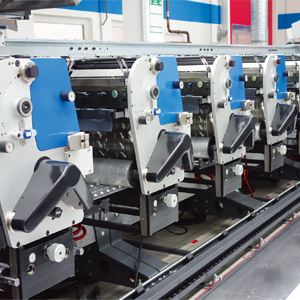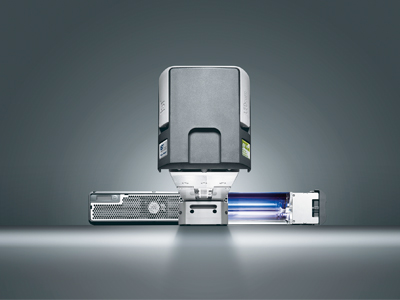The MBS system from IST
Although most manufacturers now offer some form of UV LED systems, traditional UV curing is still the main ‘drying’ technology used on narrow web presses. The market is dominated by a few major manufacturers that supply systems to press manufacturers. By Neel Madsen.
Ultraviolet, or UV, curing remains the dominant drying technology in the flexo label printing industry. UV curing systems use low pressure mercury arc lamps that emit light between 100 to 300 nanometres (nm) in wavelength. These sit in a housing surrounded by reflectors that direct the light energy to the substrate.
When exposed to ultraviolet light, molecules in UV ink known as photoinitiators will start to break up and become chemically active. This causes a polymeristation process which means that the small molecules in the free flowing ink will start to link into larger chains thereby losing their flow properties. The polymerisation reaction can be via a radical or cationic mechanism depending on the chemical structure, but the type of UV radiation is the same in both cases. The curing is instant, allowing the dry and abrasion-proof substrate to continue to the next process step at speed.
As press speeds have increased so have the UV curing systems with better lamp efficiency and reduced energy consumption. Some new systems offer the option to change to UV LED curing at a future date.
Simon Mitchell, joint managing director of IST (UK) Ltd, commented, ‘UV remains dominant in narrow web, accounting for around 95% of all new flexo machines sold in the UK. It obviously gives work an appealing aesthetic lift and enables special effects to be used, but it is the ability to take work off dry and convert it immediately that is the key advantage. It means end users can have very fast turnarounds without compromising quality.
‘Water-based inks and infra-red are alternative options, but neither yet can match the quality of UV which is really a standard in 13 inch width web and above.’
Curing options
IST (UK) Ltd is based in a 400 square metres facility in Skipton, which includes training and presentation areas, systems and spares storage as well as being the main base for the sales and service team. The company is a subsidiary of IST Metz GmbH, founded by Gerhard Metz in 1977 and today employing about 500 staff with 15 subsidiaries around the world.
IST launched its MBS series UV at Labelexpo 2015 and with this came three different versions of UV. These include what has now become known as conventional UV (as UV LED becomes an option) offering LAMPcure, an air-cooled UV for energy reduction at 120 W/cm and a higher output of 145 W/cm specifically for low migration inks. MBS HYcure, the only aircooled hybrid UV/ UV LED product on the market, which enables operating one or the other technologies without the need to modify press settings. A simple cassette change will switch the UV between LED and conventional UV, the ELC-X (electronic power supply) will recognise the change and make the necessary adjustments. Finally LEDcure is a dedicated UV LED, aircooled for printing UV LED only.
Retro service
In addition to supplying systems to OEMs, IST UK now offers a new service that will allow printers to retrofit or replace its UV and UV LED drying technology on installed presses or second-hand equipment. The first company to take advantage of this service is Jaymar Packaging, which has added a conventional UV system from IST to a Roland 700 six colour and coating press.
The privately-owned Crewe printing company had looked around for a second-hand press with UV fitted, but it could not find one to match the high standard of the 2006 model press it had located without UV.
‘We hope by adding this UV facility we can open up new markets and produce more added value work in both the pharmaceutical and high impact packaging sectors we serve,’ said Gary Marsh, production director of Jaymar Packaging. ‘It is getting harder and more expensive to outsource UV work and it is a sector in which we see an increase in demand. We want to be competitive in this area and by investing in this equipment we will be able to control all aspects of quality, lead times and more importantly costs.’
Celebrating 25 years
GEW (EC) Limited is headquartered in the UK with subsidiaries in the US, Germany and India, and operates a network of international distributors worldwide. It is celebrating its 25th anniversary this year. Looking back at the quarter century, managing director Malcolm Rae commented, ‘Everyone at GEW has worked hard to ensure that the first 25 years in business have been successful and prosperous. Trying to delve into the future of UV curing technology is bound to be a challenge, but GEW has the skills and the resources to meet that challenge.’
Energy management is a prime consideration in the design of GEW UV systems. As every component in any system generates a loss, the cumulative effect of several weak links in the chain can considerably lower the efficiency of an entire system. In UV lamps a considerable amount of heat is generated as a side effect of UV production when converting electrical power to UV light.
Excess heat generated by the system can be reduced by correct geometry and careful material design. Inadequate heat management and poor reflector configuration can add more losses by preventing the optimum output. GEW’s reflector designs use dichroic reflector surfaces and its lampheads feature patented airflow and cooling of the glass reflectors from behind. Further significant improvements can be achieved by reducing secondary sources of losses such as during burn-in or in standby mode.
Mr Rae said, ‘Optimising existing resources and available technology are the keys to successful reduction of profit-gnawing wasted energy, time and materials while at the same time improving performance and production capacity. Eliminating wasted time will increase machine time availability and can reduce unit costs. To this purpose the reduced start-up times of high efficiency arc lamp systems and the instant switch on and off capability of LED systems can drastically grow actual machine production time.’
Double peak
Hönle Group offers a range of drying systems for industrial applications, including UV curing. Its classic jetCure system for UV curing features double peak intensity for curing at high printing speeds to guarantee better printing quality. Specially developed cold light reflectors make it ideal for temperature-sensible printing substrates and the jetCure units are available with different lamp spectra. The module’s length can also be individually matched to the printing process.
Part of the Hönle Group is PrintConcept UV, which has equipped more than 600 printing presses worldwide with UV curing systems. The compact, high performance and versatile UV lamp modules can be supplied in lengths up to 2600 mm.
To address issues with migration of ink components in food packaging applications, the company offers nitrogen inertisation systems. The latest generation utilises a flat inert chamber and precise measuring techniques to minimise the amount of photoinitiators and reduce migration. Nitrogen inertisation systems can be retrofitted to all PrintConcept UV lamp modules.
LED the way
As witnessed at Labelexpo Europe last year, UV LED technology is a hot topic with manufacturers introducing hybrid systems for future-proofing printing presses.
Mr Mitchell commented, ‘Where LED UV is considered it can provide on/off capability reducing warm-up/cool-down times and it offers the ability to cure in designated smaller areas resulting in less energy used. It also has an environmental advantage in having no ozone impact. However, the capital cost can be as great as up to three times that of conventional UV and its running costs are not incomparable to conventional UV so the outlook in the short to medium term is that conventional UV will continue to dominate in the narrow web sector.’
‘As a specialist UV systems manufacturer, GEW is and has been actively engaged in researching the potential of UV LEDs for many years, but is also committed to further innovate mercury arc lamp technology for label printing, coating and industrial applications,’ said Mr Rae.
He continued, ‘We believe that the simplest solutions are the best. LEDs are the most straightforward and most effective solution for some printing applications. We are committed to working with ink manufacturers to explore and develop the opportunities for LED curing in all sectors of the industry, but we remain equally committed to building on the strengths of proven, viable technology.’
Savings at RAKO
Early in 2015, RAKO Etiketten invested in two new Gallus ECS 340 flexo presses. These are configured identically and the 12 print stations are all fitted with UV curing from GEW. Each station comprises a GD3 UV lamphead and Rhino electronic power supply.
Arne Bir, production manager, said, ‘For us GEW’s UV systems have been the industry standard for many years. By installing the GEW UV system and the Rhino power supply, we are in a position to increase production capacity and at the same time reduce production costs.
‘At RAKO performance and reliability are essential requirements for competitive high quality label manufacturing. GEW was able to offer us a complete package of efficiency, reliability and remote system performance checks.’

Gallus ECS 340 with the GEW UV system at RAKO Etiketten
GEW’s embedded service package allows the manufacturer’s engineers to remotely analyse performance data that enable them to proactively detect any out of tolerance parameters requiring maintenance and advise corrective action before a fault can develop.
The system, with its aircooled high efficiency GD3 UV units, brings additional benefits of fast burn-in and shut down times with savings in electricity consumption. Mr Bir commented, ‘Our calculations indicate that the GD3 UV lampheads together with the Rhino power supply will reduce our electricity bill by 30%. These are considerable savings, not taking into account savings from faster, more stable production with no downtime.’






